First of all I wanted to apologize for the amount of time its taken to do this one particular blog post. Reviewing such a large number of clubs at one time has proven much more difficult than I anticipated. It’s not that it was hard for me to hit the clubs or even study them as I love testing clubs and writing reviews on the blog. The hard part was the logistics of putting this whole test together. Just arranging for each brand to send me their clubs within a window which I could have all the clubs side by side proved impossible. In no way am I blaming the brands for not being able to do this review in a timely manner, on the contrary, I am very grateful for all the demos they always send me when I ask for them so I’m not complaining.
Taylormade Japan decided to regroup my Burner Forged and R9 Forged demos along with the new Supermax clubs they will be sending me later this month. As many of you know I was waiting for those two clubs to round out the contenders in this test. In the end I’ve decided to go ahead with the test since a lot of people including myself are waiting, but now in two groups which may end up easier to do. The tests will go as follows with each group’s tests broken up into two parts, 1. design and aesthetics and 2. feel and performance. Group 1 will begin with this post and Group 2 sometime in September (pray it does not take as long as this one did!) before the release of most of those models in group 2.
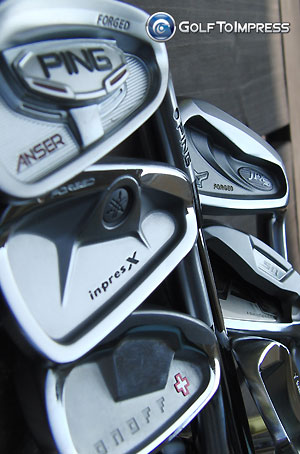 Group 1:
Group 1:
Epon Forged AF-502
Nike Japan Machspeed Forged
Mizuno JPX AD Forged
Honma MG700 Forged
Yamaha Inpres X V Forged
Ping Anser Forged
ONOFF Plus Forged
Tourstage X-Blade 703 Forged
Sri Sports XXIO Forged
Group 2:
Taylormade Japan Burner Forged
Taylormade Japan R9 Forged
Titleist VG3 Forged
Tourstage GR Forged
Fourteen TC-550 Forged
Callaway New Legacy Forged
PRGR GN502 Tour Forged
Sky Dream Jump CF-I Tour Forged
A few things to note before I begin the shootout and this is something I always stress in all my reviews. Reviewing golf clubs is very subjective. I try my best to give an unbiased opinion on all the clubs though I may subconsciously lean towards irons that suit my personal tastes and skill level. What I present is my opinion based on my knowledge of testing and studying golf clubs in the Japanese market which may differ from the next person’s opinion. Having different opinions is not a problem at all though. We are all different golfers, with different swings and different tastes and perceptions.
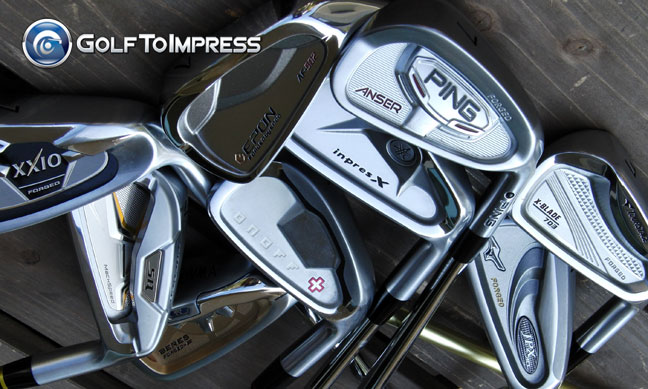 At the end of the test I will definitely choose a set of irons out of all these contenders to be my new gamers. This set will not be declared the “winner” as when it comes to golf clubs, it’s almost impossible to choose one single standout club for the general golfing public. The fact is, if there was one “Best” club, wouldn’t everyone be playing it? The set I choose at the end of test will be the best set FOR ME. I’m doing this shootout so that everyone reading it can find enough information and see enough examples of these irons to choose the best irons for their game. It doesn’t matter how good an iron is or how soft it is if it doesn’t match he players ability. If a player cannot strike the iron well it won’t feel good no matter what.
At the end of the test I will definitely choose a set of irons out of all these contenders to be my new gamers. This set will not be declared the “winner” as when it comes to golf clubs, it’s almost impossible to choose one single standout club for the general golfing public. The fact is, if there was one “Best” club, wouldn’t everyone be playing it? The set I choose at the end of test will be the best set FOR ME. I’m doing this shootout so that everyone reading it can find enough information and see enough examples of these irons to choose the best irons for their game. It doesn’t matter how good an iron is or how soft it is if it doesn’t match he players ability. If a player cannot strike the iron well it won’t feel good no matter what.
Also please keep in mind I am not a professional photographer. I do however like taking pictures and I try my best to take the prettiest pictures possible and images that reflect the actual clubs. Please excuse any inconsistencies in picture taking and dirty club faces as sometimes I took pics after hitting them at the range and others were taken before being hit (I realized this after I sent the demos back).
Well enough blabbering lets get on with the review!
Click Read More to continue with GTI’s Forged Cavity Shootout Part 1!
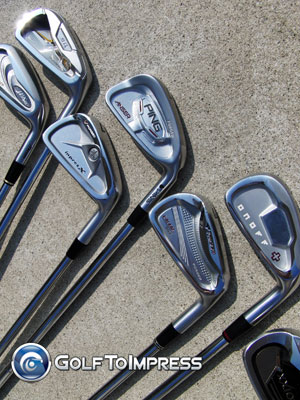 None of the models I requested in this test are small compact irons aimed at the athlete/pro golfer and most are probably mid sized or between mid and small size thus appealing to a large range of golfers. I did this intentionally as pro spec irons are only playable by a very small handful of golfers while mid level cavity backs can be played by single digit golfers wanting forgiveness all the way up to improving average golfers who want a challenge. In other words the irons here appeal to the broadest audience with many offering something for everyone.
None of the models I requested in this test are small compact irons aimed at the athlete/pro golfer and most are probably mid sized or between mid and small size thus appealing to a large range of golfers. I did this intentionally as pro spec irons are only playable by a very small handful of golfers while mid level cavity backs can be played by single digit golfers wanting forgiveness all the way up to improving average golfers who want a challenge. In other words the irons here appeal to the broadest audience with many offering something for everyone.
I’m going to begin with this first post looking at the design of each iron and it’s aesthetics. Let’s face it if an iron doesn’t look good you’re probably not going to want to buy it or play it while a hot looking iron gets a lot more attention. Many of us put a lot of emphasis on offset and top line which have an impact on our visual perception at address.
The first part of the each club we will look at is the back cavity of each iron. This part of the iron is the part we never see really as its hidden at address and when we swing the club, nevertheless, it plays an important factor design wise and when influencing our purchasing decisions.
Pictures are worth a thousand words but I’ll give my commentary and feedback on each aesthetic aspect and some design points but for the first part of this review I won’t really delve into how these design aspects affect performance which is something I will do in Part 2.
Technology sure plays a big part in today’s club designs. Of the 9 irons above, only 2 irons are true 1 piece forged irons while all the rest are multi piece designs some integrating non traditional materials for a so called “forged” iron. The S25C Tourstage X-Blade 703 Forged and the S20C Yamaha Inpres X V Forged are very good looking 1 piece forged irons that look very cutting edge, muscular and ready for business. The 703, V Forged and ONOFF Plus forged are the only 3 irons that don’t feature some sort of undercut cavity vibration type technology behind the face. I’ll get into materials more during the performance and feel tests as that is what they impact.
The XXIO Forged, Honma MG700 Forged, Mizuno JPX AD Forged and Nike Machspeed Forged all feature a pocket style cavity and at least two different materials. The Epon Forged AF-502 and Ping Anser Forged both feature vibration dampening in the form of alpha gel in a hollow pocket for the Epon and Ping’s CTP or custom tuning port for the Anser Forged.
Looks are very personal but I find the ONOFF the cleanest looking and the Yamaha the best looking with its double “fang” like cavity. I actually really like the flat finish of the Ping Anser, it’s pretty much no reflective and has a white satin look to it.
Four of the irons, the ONOFF, Honma, Mizuno and Ping feature a tungsten weight sole to lower CG and increase launch.
The XXIO Forged has the largest pocket cavity and it shows as the cavity looks bulky however this could equate to major forgiveness as the XXIO is also the biggest all around head. The Mizuno is a bit plain looking and it’s the longest head from heel to toe. The Nike looks the most mechanical and a touch boxy from the cavity view but I actually prefer it’s looks over say the Honma. Epon’s workmanship is top notch as always and the AF-502 looks expensive and while I prefer a satin look, its combination satin and mirror chrome do work.
The X-Blade 703 is the smallest overall head.
The design of these back cavities will play a part in how the iron sounds and impact and even ultimately how its feel is perceived.
The face is a part of the iron we we do see more at address and it’s shape plays a part in no only how the iron looks but performs. A higher sharper toe gives the illusion of an iron that resembles a wedge allowing for more shotmaking and control. This is one of the reasons pros and lower handicappers like boxier sharper lines in their irons. I drew in some red lines to reference some of the key lines in each iron.
The width of the face as well as the sweet spot/CG placement on the face has a direct impact on how easy an iron is to play and how forgiving it is. The Mizuno JPX AD has the widest face area and one of the lowest sweet spots thanks to that tungsten sole and pocket cavity that push the CG very low in the head. The smallest face area goes to the X-Blade 703 Forged which is not surprising as this is the model in the test that borders most closely to a pro model (in fact it is in play by several top Tourstage pros in Japan).
The largest face again goes to the XXIO Forged which has very curved lines aimed to build confidence for the average golfer wanting to play a forged iron. The taller overall face even at the heel portion provides forgiveness for balls hit high in deeper rough.
The straightest topline goes to the V Forged and the sharpest toe surprisingly to the Nike Machspeed Forged which has a very sharp looking face. The tallest toe is a toss up between the Anser Forged and the V Forged.
Another aspect we notice from the front view is the length of the hosel in an iron. The ONOFF Plus narrowly has the longest neck over the Yamaha and Mizuno while the Honma has the shortest stubbiest hosel by a long margin. A longer neck provides flow at address however if the insertion depth is not deep it disconnects the shaft from the head. A shorter hosel which we are beginning to see in certain wedge and iron designs recently is said to increase MOI and closer join the shaft to the head for stability.
It’s a tough call as to which face shape wins out however my personal preference says I really like the Nike’s face shape.
All these heads have some amount of offset, they are after all geared towards wider ranges of players and the amount of offset in these irons will help different levels of players square the head to the ball by allowing more time for the head to rotate and meet the ball. I actually find it difficult visually to distinguish between the amount of offset in the bulk of the irons here. None of them have a straight straight neck with the appearance of no offset but at the same time none of them have HUGE offset. (it could be my picture taking)
The Mizuno JPX easily has the thickest top line by a long shot. It is approximately 1.5 – 2 times more thick than the V Forged right below it which probably has one of the thinnest top lines.
The Ping and the Honma follow the JPX with the next thickest top lines and all the other models fall closely in line after these two. The V Forged, X-Blade 703 and the Machspeed Forged have the 3 thinnest top lines followed closely by the ONOFF Forged and surprisingly XXIO. The Epon is middle of the road.
Here at address you can really see the difference in the longer neck of the ONOFF versus the short neck of the Honma.
The X-Blade 703 and ONOFF look very appealing to me in the address position. I also like the irons that use a plain all black ferrule making for a clean visual appearance.
None of the irons in the test have a particularly wide sole. Luckily the Mizuno’s sole is not proportional to its thick top line or it may as well be in the game improvement category. If I had to say one sole was the widest it would be the Honma. A wide sole is not necessarily a bad thing, in fact irons like the PRGR EGG and Maruman Shuttle are popular because their soles are wide as hybrids which prevent digging and hitting fat shots. However in this mid to better player range we see an acceptable amount of sole width enough to function well in tight lies or harder surfaces but not too narrow to suffer in plush conditions.
The most forgiving looking leading edge goes to the AF-502 which features an obviously blunt leading edge but rather flat sole from leading to trailing edge. The ONOFF on the other hand has a more rounded sole from leading to trailing edge allowing it to hit more consistent shots.
I should have noted above in the face profiles that the roundest leading edge, that is from the toe to heel which also add forgiveness are the Yamaha, Ping and Honma. These grinds like blunt leading edges, trailing edge relief, rounded or cambered soles all help a player make more pure contact resulting in better feel. So when players automatically look at materials or whether an iron is forged or cast, there is much more to an irons design that will affect its feel. And then on top of that we need to take the shaft into account.
From the sole angle here you can see how wide the tungsten is on the irons that feature weighting. The Honma places the weight at the heel and toe of the sole while the Ping, Mizuno and ONOFF actually use tungsten as part of the back sole.
The X-Blade which is considered the closest to a pro model actually has quite a forgiving grind with a lot of trailing edge relief as well as heel relief that prevents the heel from going into the ground causing a pull.
So there you have a brief look at design and aesthetics. Visual judgement is much more subjective. As individuals, readers can look at the images and basic info and decide which one suits their visual tastes. Looks wise for me I really like the Yamaha, Tourstage and ONOFF. I wonder how much weight a buyer puts on looks versus performance/feel? I know its definitely part of the equation.
In Part 2 where I measure feel and performance I will come right out and say this iron goes higher than that one, or this iron is softer than that one, or this iron is more forgiving than that one. Remember also that I will be testing a second group of irons in coming weeks. I’m just keeping my fingers crossed that they can all arrive here in a timely manner!

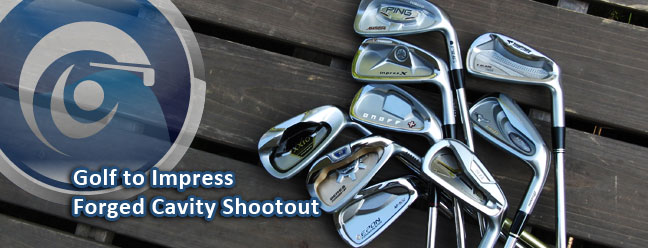
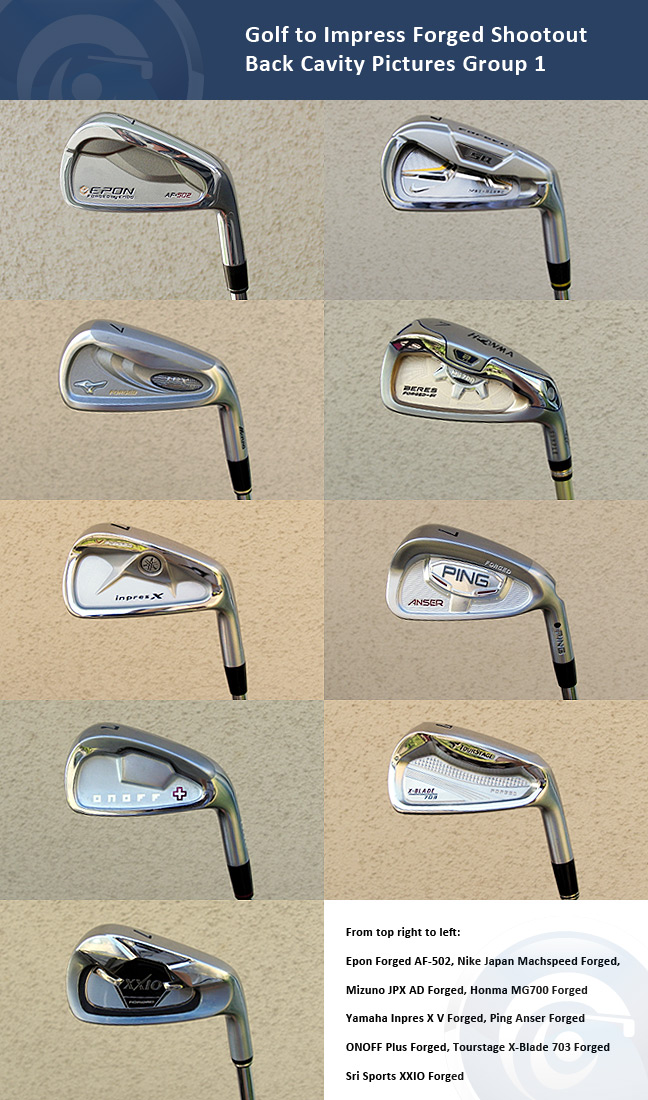

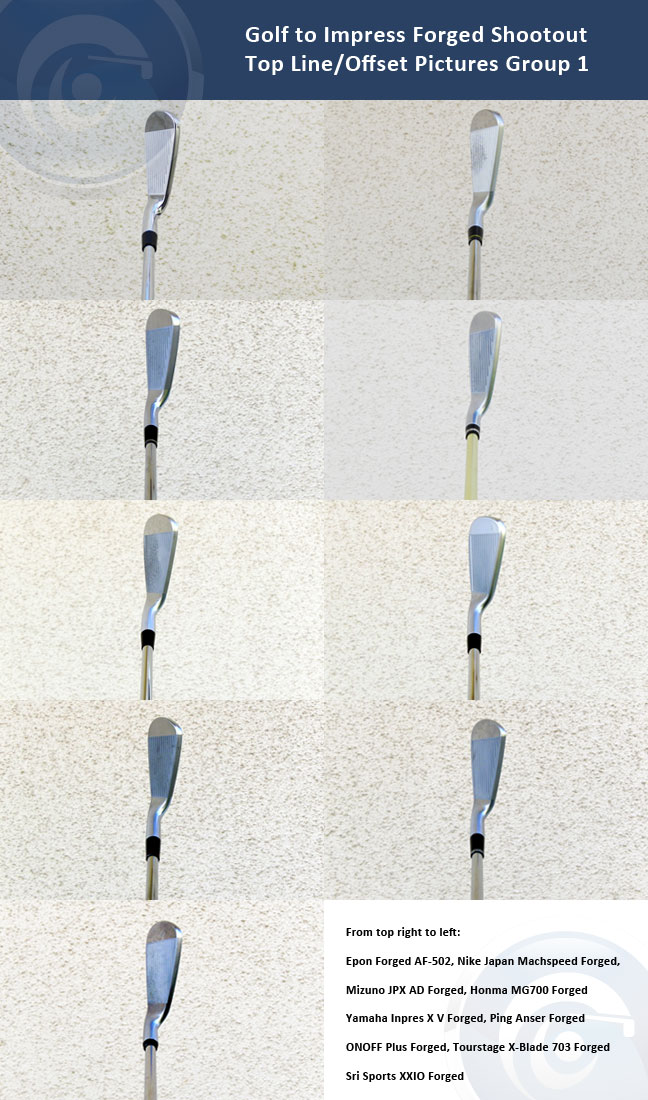
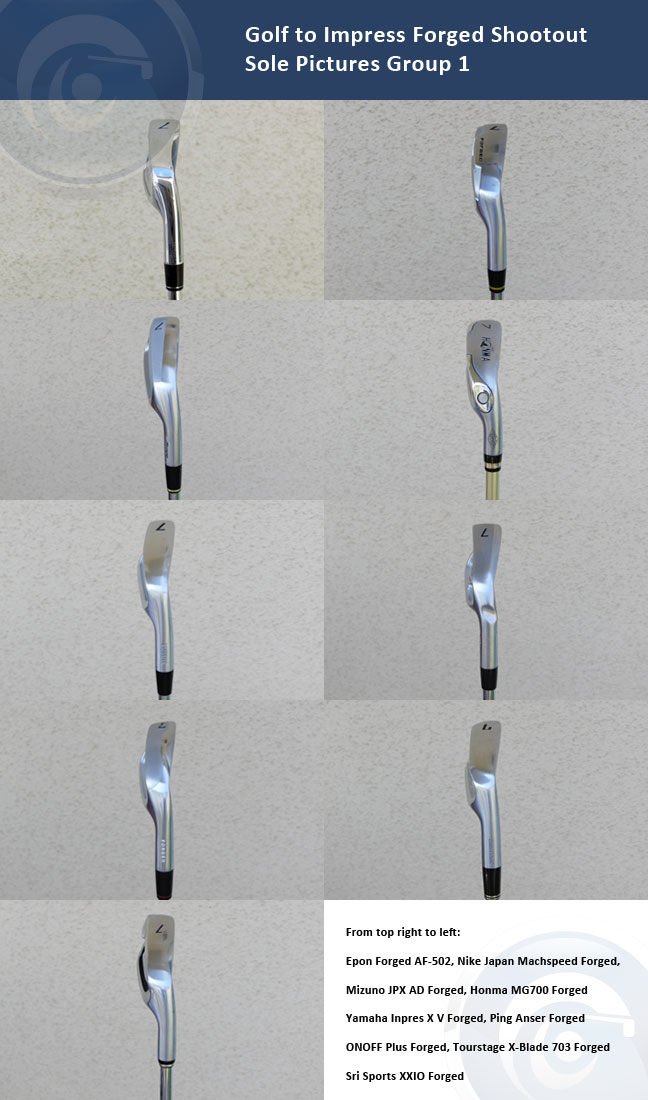


Errrrrrr buddy, that’s AESTHETICS, aesthics is not a word.
Personally, I like a slightly rounded bottom (like the Honma), sharp top edges, small head and a minimal off-set.
Haha thanks, it was just a typo in the title, at least I spelled it correctly in the body of the post.
Your passion for this stuff is absolutely great! Thanks for taking the time.
Thanks for posting this, the picutures are great. Do you think you could post larger images of the irons maybe at the end of the test? It would be especially helpful looking at the top line address pics.
Thank you for doing this comparison. Sooooo disappointing of TaylorMade, not only for taking the demos back, but for delaying the reviews.
Ever consider borrowing a Ping Flightscope or similar systems from a retailer? If you give them some free publicity they should let you take out to the range.
Having numbers such as apex height, distance, spin, dispersion, would take much of the subjectivity out of it.
One last suggestion, if you have a clubfitter friend, maybe they could take out a set of calipers and measure each iron from heel to toe, top line width, sole width and offset. Posting those numbers (such as Golf Digest HL does) would take out any optical illusions created by the design.
I know its added work but it would be truly beneficial to prospective buyers such as myself. Hey, fly me out and I’ll lend a hand!
Your Message@gocchin:
Yeah but you still have it wrong in the LINK! hehehehe
I know that. But once I publish the document I can’t change the link as it has been already dugg and tweeted and spidered so if I change the url it will break the link. So the link remains Aesthics. (^_^)
Your Message@gocchin:
Oh come on you know you can change it, it’s no big deal, people can find it again LOL
You did a great job review. Thank you.
Absolutely terrific overview. Thank you for the time and effort. Extremely helpful in every way.
Part 2 will be published … when?
Hope to have the performance results in Part 2 up sometime this week… it’s been one busy summer! (^_^)
Love this stuff…can’t stop re-reading this review and can’t wait for the second installment.
Thanks for the time invested to bring us this information.
Please post Part 2 soon and as you have received the TM R9 Forged and TM Burner forged, please include their feel and performance with this Part 2. It would seem to make sense.
Coming up on Christmas . . . = sales
Thanks
I desperately want to find the time to do part 2 but unfortunately blogging is only a small portion of my job and I have a hard time finding the time to do so these days with all the work I have. The shootout is a huge undertaking and if blogging was my only responsibility it’d be up long ago!
So I do apologize for the time it’s taken. 18th, you know you can email me anytime and ask me what I think of all the irons. I get 50-60 emails a day… and many contain the exact question you want to know ie how the burner forged compares to the r9 forged. (^_^)
I have been waiting for installment #2 like the rest of the golf nuts seeking the holy Grail of forged feel and a little forgiveness for good measure. I own the burner tp irons with Nippon shafts and think they’re awesome clubs in every aspect but my sickness (golf addiction) compels me to keep checking back into the site for the second installment. Since it sounds like your job may get in the way of you finishing the comparison can you share your opinion on what set came close to offering the quality look and gel of the burner tp irons? I like thin topline, very soft feel,little or no offset ,and medium/ small faces.if there is a model with these features that yields a bit of a higher ballflight , would probably have to buy them immediately. My second favorite clubs that I’ve owned were the tourstage 701g set I had with Nippon shafts. Any feedback would be very much appreciated.
I’ve begun working on Part 2 and I’ve decided at this point to throw in the R9 Forged and Burner forged and Titleist VG3 as well since there is no telling when the manufacturers send me their demo clubs meaning group 2 will be just as hard to put together as group 1. So I may as well get everything I’ve actually tested in this upcoming results portion.
Your Message
Aesthetics is personal. Personally, I think the Nike is hideous. My preferred designs in this batch are the Tourstage and Onoff. The others are a tad busy but then again aesthetics alone doesn’t win the battle.